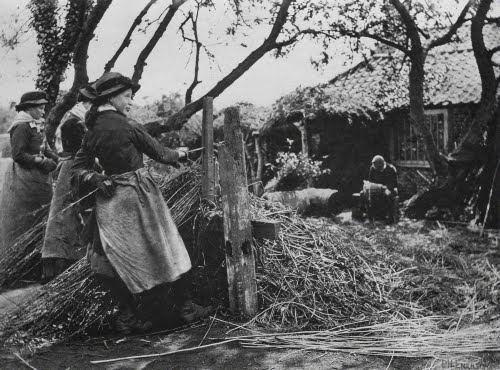An Art Ode to Labor Day Week: Peter Henry Emerson
We should take a “time out” in the corner if we ever complain about what we have to wear to work, whether it’s a uniform, suit, or office casual. Can you imagine working outside doing physical labor in a corset, petticoats, full skirt, apron, and hat???? These women are engaged in “osier peeling,” stripping off the outside of hollow, jointed tall grass called reeds. The resulting stripped reeds would then be made into baskets, hats, etc. Reeds in Britain must continue to have a lot of uses because they are still harvested every year in Norfolk from December through April. I assume, though, that a lot of the work is automated by now.
Labor Day Week continues with rural life in late-1800s England.
 |
| Peter Henry Emerson (1856–1936, Britain), Women Working Reeds, from the series Pictures of East Anglian Life, 1888. Photogravure on paper, 8 ½" x 11 5/16" (21.7 x 28.7 cm). Image © 2017 Davis Art Images. (8S-20612) |
Toward the end of the 1880s in England, banal, posed genre subjects flooded the market. Instead of direct imagery, traditionally considered the strength of the medium, these photographs were little more than “cut and paste” handwork. Photographers would take as many as five negatives of staged tableaus, arrange them on one plate, and print them together as one. Composite printing could produce ghostly secondary images that were meant to represent memories, ghosts, or visions to the higher contrast primary scene.
Some photographers, such as Peter H. Emerson, reacted against reducing photography to the sentimental and artificial. Emerson introduced the theory of Naturalism. He believed that the photographer should photograph natural settings, not posed studio shots. He also believed in having the central subject in sharp focus and the surrounding background slightly out of focus, for he believed that that was the way the human eye sees.
Emerson studied medicine and science in college. He bought his first camera in 1882 and studied the medium with the typical thoroughness of a scientist. He first exhibited his photographs, winning many prizes, in 1885. He was an avid lecturer and writer on his aesthetic theory of Naturalism. Like many of the art photographers, he believed that photography could be an art in its own right.
In 1888, he began to document the rural life of East Anglia. Many indigenous customs and traditions were fast disappearing, and Emerson saw in them an inherent nobility, much like Realist painters. The gravure print process was a perfect medium for capturing the misty atmosphere of that region of England. This photograph is a quintessential example of his theories.
Emerson explained his theories in the book Naturalistic Photography published in 1889. His ideas about using natural settings and unposed subjects as art photography influenced Pictorialism in the U.S. at the turn of the 20th century, when art photography had its last peak of popularity.
Check back tomorrow for a bonus Saturday post to wrap up the Labor Day Week series.
Correlations to Davis programs: Focus on Photography 1E: 2, 3; Focus on Photography 2E: 4


Comments